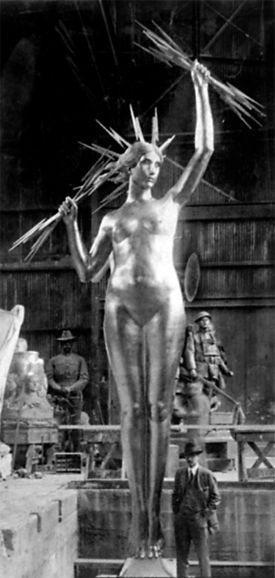Electra: Difference between revisions
Patriarca12 (talk | contribs) (first try) |
No edit summary |
||
| (10 intermediate revisions by 2 users not shown) | |||
| Line 1: | Line 1: | ||
'''Electra''' is the 23-foot-tall, golden statue atop the eastern end of the tiled roof of the [[ | :''This article is about the statue on the roof of the Alabama Power Building. For other uses, see [[Electra (disambiguation)]].'' | ||
[[Image:Electra in studio.jpg|right|thumb|275px|Electra in Sanford's New York studio before delivery to Alabama]] | |||
'''Electra''' is the 23-foot-tall, golden statue atop the eastern end of the tiled roof of the [[Alabama Power Building]] at 600 [[18th Street North]]. | |||
The original plans for the building included a lighted "Alabama Power Co." sign running along the top of the ridge. Architect [[William Warren]] suggested that the board consider an alternative, a statue representing "the state of Alabama rising triumphantly in her electrical progress". The suggestion was approved by a unanimous vote. | |||
In [[1996]] to celebrate her 70th anniversary, Electra was completely cleaned and regilded. | Electra, originally entitled "Divinity of Light," was sculpted by Edward Field Sanford, Jr of New York. His design consisted of a graceful nude female holding six lightning bolts over her head. The 4,000 pound bronze casting was covered in gold leaf. | ||
The statue was secured in place on [[May 10]], [[1926]]. That summer, ''[[Birmingham Post]]'' satirist "[[E. T. Leech|Dr. B. U. L. Conner]]" began a series of illustrated fanciful episodes in the courtship of Electra by Birmingham's other scantily-clad mythical colossus, [[Vulcan]]. The potholes on [[18th Street North|18th Street]] were explained as the smitten god's footprints. The popular serial cemented the pair's storied connection into the city's common folklore even before Vulcan was moved to [[Red Mountain]] in the 1930s. | |||
During construction of the [[Alabama Power Corporate Tower]], a marble replica of Electra was commissioned for display in the atrium. Andrew Wielawski carved the figure from white Carrara marble in his studio in Italy. It is displayed on a base of black Chinese marble. The sculpture was dedicated on [[June 25]], [[1988]]. | |||
In [[1996]] to celebrate her 70th anniversary, Electra was completely cleaned and regilded. In the Summer of [[2016]] Alabama Power hosted an exhibit entitled "Electra: The Divinity of Light: 1926-2016", including historic artifacts and memorabilia alongside interpretations of the figure rendered by local artists. | |||
==References== | ==References== | ||
* Kemp, Kathy (October 19, 2003) "Art show may rekindle mythic love." | * Conner, Dr. B. U. L. (July 1926) "Love Story of Vulcan and Electra." series. ''The Birmingham Post'' | ||
* Kemp, Kathy (October 19, 2003) "Art show may rekindle mythic love." {{BN}} | |||
* {{Atkins-2006}} | |||
* Tharpe, Bill (May 17, 2016) "Electra statue turns 90 years old, remains Birmingham beacon." Southern Company/Alabama NewsCenter | |||
* Kazek, Kelly (August 13, 2020) "The story of Miss Electra, Alabama’s golden goddess." {{BN}} | |||
[[Category:Sculpture]] | [[Category:Sculpture]] | ||
[[Category:Symbols of Birmingham]] | [[Category:Symbols of Birmingham]] | ||
[[Category:Alabama Power]] | |||
[[Category:1926 works]] | [[Category:1926 works]] | ||
Latest revision as of 14:47, 21 October 2020
- This article is about the statue on the roof of the Alabama Power Building. For other uses, see Electra (disambiguation).
Electra is the 23-foot-tall, golden statue atop the eastern end of the tiled roof of the Alabama Power Building at 600 18th Street North.
The original plans for the building included a lighted "Alabama Power Co." sign running along the top of the ridge. Architect William Warren suggested that the board consider an alternative, a statue representing "the state of Alabama rising triumphantly in her electrical progress". The suggestion was approved by a unanimous vote.
Electra, originally entitled "Divinity of Light," was sculpted by Edward Field Sanford, Jr of New York. His design consisted of a graceful nude female holding six lightning bolts over her head. The 4,000 pound bronze casting was covered in gold leaf.
The statue was secured in place on May 10, 1926. That summer, Birmingham Post satirist "Dr. B. U. L. Conner" began a series of illustrated fanciful episodes in the courtship of Electra by Birmingham's other scantily-clad mythical colossus, Vulcan. The potholes on 18th Street were explained as the smitten god's footprints. The popular serial cemented the pair's storied connection into the city's common folklore even before Vulcan was moved to Red Mountain in the 1930s.
During construction of the Alabama Power Corporate Tower, a marble replica of Electra was commissioned for display in the atrium. Andrew Wielawski carved the figure from white Carrara marble in his studio in Italy. It is displayed on a base of black Chinese marble. The sculpture was dedicated on June 25, 1988.
In 1996 to celebrate her 70th anniversary, Electra was completely cleaned and regilded. In the Summer of 2016 Alabama Power hosted an exhibit entitled "Electra: The Divinity of Light: 1926-2016", including historic artifacts and memorabilia alongside interpretations of the figure rendered by local artists.
References
- Conner, Dr. B. U. L. (July 1926) "Love Story of Vulcan and Electra." series. The Birmingham Post
- Kemp, Kathy (October 19, 2003) "Art show may rekindle mythic love." The Birmingham News
- Atkins, Leah Rawls (2006) Developed for the Service of Alabama: The Centennial History of the Alabama Power Company, 1906-2006 Birmingham: Alabama Power Company. ISBN 0978675304
- Tharpe, Bill (May 17, 2016) "Electra statue turns 90 years old, remains Birmingham beacon." Southern Company/Alabama NewsCenter
- Kazek, Kelly (August 13, 2020) "The story of Miss Electra, Alabama’s golden goddess." The Birmingham News
